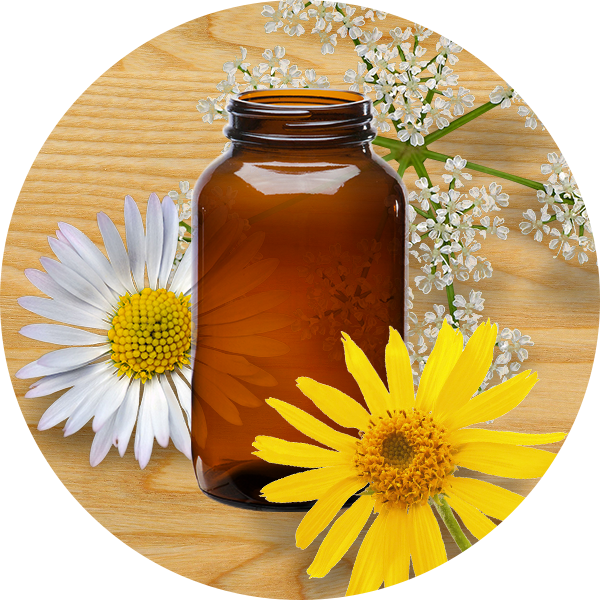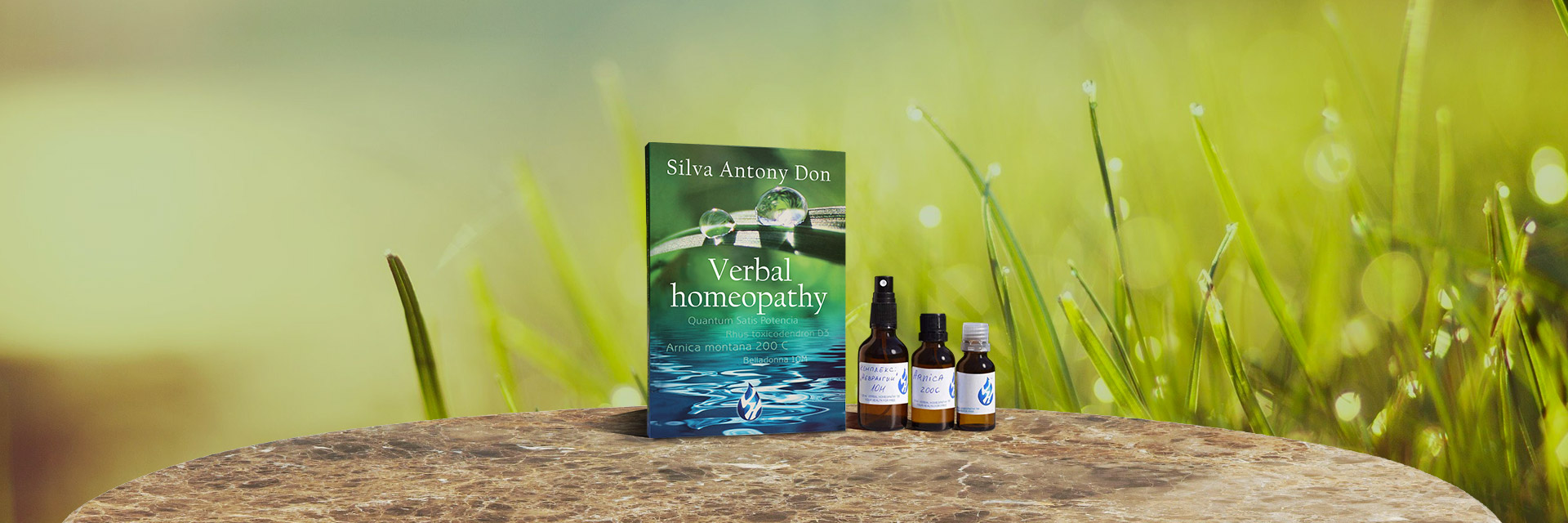1. Arnica montana – Arnica. Say [Arnika montana D3, 200C, 10M].
Indications: any traumatic injury from car accidents, falling, fractures, domestic injury, thrashing, surgical intervention, including childbirth; it works as a potent vascular protector – prevents the development of blood clots, rapidly disperses suffusions such as hematoma, ecchymoses, varicose; relieves all types of bleeding; helps manage states of shock quickly; significantly reduces pain; acts preventively in hypertensive and cardiac-disease patients and alleviates the condition in stroke or heart attack; in such cases it is often life-saving.
This remedy is used in all types of muscle fatigue, climbing, lifting and carrying weight, field/garden work, work in construction, athletics. The remedy prevents or reduces the pain in muscle fever, relieves muscle load, allows for much easier recovery; it should be taken before, during, and after such exertion.
This is also the main remedy for childbirth – it should be taken continuously from the first moment of starting labor, during labor and until full recovery after 30–40 days. Once you begin recovering, decrease the dosage. Arnica can be taken during labor every 5 minutes; it is compatible with any type of surgical intervention.

2. Bellis perennis – English daisy. Say [Belis perenis D3, 200C, 10M].
Indications: hits after car crashes or other accidents in the region of the stomach and pelvis; it protects from hemorrhages and alleviates the condition following them; it should be taken intensively for a month or two after the injury, and possibly longer, depending on the severity of the accident, but for at least a month after the symptoms (pains) have abated, in view of deep internal injuries that cannot always be identified.
Patients often die of internal bleeding a couple of months after the accident, especially after they have been discharged from the hospital. In this sense, both Arnica montana and Belis perennis have no analogy in medical practice with respect to their preventive function. Their prolonged and regular administration effectively prevents such complications.
3. Conium maculatum – hemlock. Say [Konium makulatum D3, 200C, 10M].
Indications: heavy hits following accidents in the chest region; helps recover faster and alleviates hemorrhages in that region; it should be taken for at least a month after the symptoms (pains) have abated, in view of deep internal injuries that cannot always be identified; it affects acute paresis of the motor and sensory nerves following accidents; it is conducive to the dispersal of various types of concretions in the body due to accidents.
4. China rubra – cinchona tree. Say [Hina rubra D3, 200C, 10M].
Indications: used to treat small to medium-volume hemorrhages due to accidents; relief in heavy blood loss (internal and external); the remedy is administered alongside other emergency therapeutic measures; nosebleed, recovery after heavy blood loss and accidents – in such cases it should be taken for months.
5. Phosphor – phosphorus. Say [Fosforus D3, 200C, 10M].
Indications: frequent recurring profuse bleeding; this remedy helps manage small to medium-volume hemorrhage due to various accidents; in heavy blood loss, it is combined with traditional styptic agents and treatment methods (blood transfusion, antishock therapy, hemostasis), nosebleed, intestinal bleeding (effectively combines with other treatment methods), profuse bleeding in the urine (hematuria), profuse heavy menstruation with a risk of anemia, stomach ulcer bleeding, bleeding from ulcers and wounds that bleed abnormally, blood in the saliva (hematemesis).
The preparation should be given continuously during the incident and for about a week to a month after the symptoms have abated, depending on the severity of the case, in view of avoiding future complications. It combines with any other emergency measures such as transfusion, antishock therapy, surgery.
In anemia and severe blood loss, the treatment lasts for months until the patient is fully recovered. The remedy can be successfully combined with Ferrum metallicum or Ferrum phosphricum, as well as with China rubra.
6. Sulfuric acid. Say [Sulfurik asid D3, 200C, 10M].
Indications: post-traumatic persistent suffusion with deep pain, stiffness and severe infectious conditions; risk of sepsis and internal hemorrhage; bleeding of black blood.
This preparation may very well follow Arnica montana, especially in persistent suffusion and complications, accompanied by headache and the sensation as if the brain were rocking inside the skull.
7. Bothrops Lanceolatus – viper venom. Say [Botrops Lantseolatus D3, 200C, 10M].
Indications: various types of bleeding with black non-coagulating blood and a near-collapsing state; lethargy, pale marbled skin, cyanosis, shortness of breath, weak pulse; cerebral hemorrhage (stroke), bleeding in the stomach, deep arterial thrombosis, thrombophlebitis, nosebleed, capillary bleeding, suppurative super-infection.
8. Carbo vegetabilis – medicinal charcoal. Say [Karbo vegetabilis D3, 200C, 10M].
Indications: state of collapse: general weakness, pale-gray to bluish face, cold skin covered with cold sweat on the forehead and face, cold breath, rapid and shallow breathing, weak pulse; the need to fan oneself is very typical – this relieves the person suffering (often, in homeopathy, this preparation is called “reviver of corpses”); it can be applied in conditions of acute respiratory failure and heart failure as an adjunctive to the classical treatment; also used in bleeding with black blood.
9. Hydrocyanic acid. Say [Hidrotsianikum atsidum D3, 200C, 10M].
Indications: emergency assistance in cases of stenocardia with arrhythmias and a propensity to collapse (weakness and freezing), cerebral vascular incidents (stroke) with suffocation and cyanosis.
This preparation is extremely useful in cases of drowning and suffocation.
10. Ledum palustre – marsh tea or wild rosemary. Say [Ledum palustreh D3, 200C, 10M].
Indications: suffusion in trauma (clots around the eye from a hard object, around the fingertips and feet); the skin is cold and marbled; traumas from stabbing, biting and stinging (thorns, nails, blades, knives, needles, animals and insects); itching and rash; the symptoms are relieved by cold and worsen by warming.
11. Hypericum perforatum – Perforate St. John’s-wort. Say [Hiperikum perforatum D3, 200C, 10M].
Indications: any type of nerve injury resulting from puncture, crash, laceration, cut; crushing and bruising of the limbs; any stab wound – puncture, biting, stinging; nail extraction; phantom pain in severed limbs; after-effects of neurosurgical intervention; cranial and brain trauma with headache and memory disorders; facial neuralgia by cold (in the first days or at the moment of paresis); tooth extraction – the pains along the nerves are distributed centripetally, worsen sharply by touch.
12. Manganum metallicum – Manganum. Say [Manganum metalikum D3, 200C, 10M].
Indications: overall feeling of bruising; tearing pain and pain as if from bruising in the limbs and joints; this is often accompanied by agonizing reliving of the situation, depressive syndrome, severe fatigue, anorexia.
After saying the name of each preparation, shake the vial vigorously.
The complex described here can all be prepared using the universal attenuation “quantum satis potentia” . Find out more on chapter 28.


